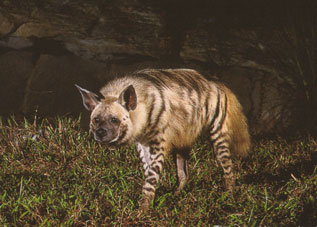
|
|
General Information
General Information Size Length: 1.45m from head to tail
Height: 0.60 to 0.95m
Weight: 25 to 55kgs
Physical Characteristics
The striped hyena has black stripes on its yellowish-beige body to provide
ideal camouflage among the long grass of the savannah and scrub.
The long hair, called hackles, on the back of its neck can be erected during a hostile confrontation to intimidate the opponent.
Habitat
The striped hyena has the widest distribution of the four species of hyenas
(spotted, striped, brown hyenas and aardwolf), ranging from Africa through
the Middle East and India. It is a predominantly solitary and nocturnal animal but it occasionally
forms small family groups of two or three. In the day, it hides among dense
vegetation or in abandoned burrows.
Feeding and Breeding
The striped hyena is mainly a scavenger, feeding on carrion and foraging rubbish dumps in areas of human habitation. In fact, some locals encourage the hyenas to pick over their waste, even providing special holes on village holes to allow them access to their rubbish dumps.
The striped hyena wastes nothing and it will carry whatever it cannot finish to a hiding place for later retrieval. It can digest material left by most other mammals.
Indigestible substances like hoof and bone are regurgitated in the form of pellets after extracting all nutrients from them. It also eats fruit like dates, melons and peaches, and sometimes it steals crops from plantations.
The striped hyena also feeds on crabs, grass, smaller antelopes, berries, worms, birds and insects. Eggs are their favorite food. Occasionally the striped hyena hunts for prey such as small mammals, insects, birds and reptiles, especially snakes.
It is also known to take down larger prey like antelope, and domestic sheep and cattle.
Some striped hyenas are solitary while others form very strong pair bonds. At times where food is plenty, the female gives birth to 2 - 4 pups in alternate years, after a gestation period of about 90 days. In captivity where food is available, the striped hyena can produce 2 litters a year.
The pups are fully furred and striped at birth, but are blind and helpless for 5 to 9 days. They are suckled by their mother and other female relatives from their small family.
After weaning, these relatives will help bring them food till they can fend for themselves at 4 to 5 months. The father striped hyena also helps to look after the pups for some time.
The pups reach sexual maturity at between 2 to 3 years. The striped hyena can breed all year round.
Conservation
Spotted hyenas, lions, leopards, tigers, cheetahs, poachers, the human, and snakes are all enemies of the Striped Hyenas. The main rival is the fennec fox. As such, itŐs estimated that there are only 2000 left in the wild.
Interesting Facts
Hyena Society
Female-dominated and clan-oriented, hyena society is one of the most complex
in the animal kingdom. Their successful adaptations to life on the competitive
plains of sub-Saharan Africa have sustained their populations where others
have failed.
Hyena Sounds
In addition to their trademark "laughing" sound, which actually expresses
fear or excitement, these much-maligned creatures have a variety of calls,
growls and grunts that they use to communicate with one another.
Are Hyenas Related to Dogs?
No. Hyenas are a family of their own, the Hyaenidae. They're more closely
related to cats than dogs, but their closest relatives are the Herpestidae
-- mongooses, meerkats and such.
Bibliography
- Wildlife Fact File -The Striped Hyena (Card 218)
- Overview of the hyenas
- General Info of hyena family
- FEMALE HYENAS AND MALE HORMONES
This website is best viewed using Internet Explorer at 800 X 600 resolution